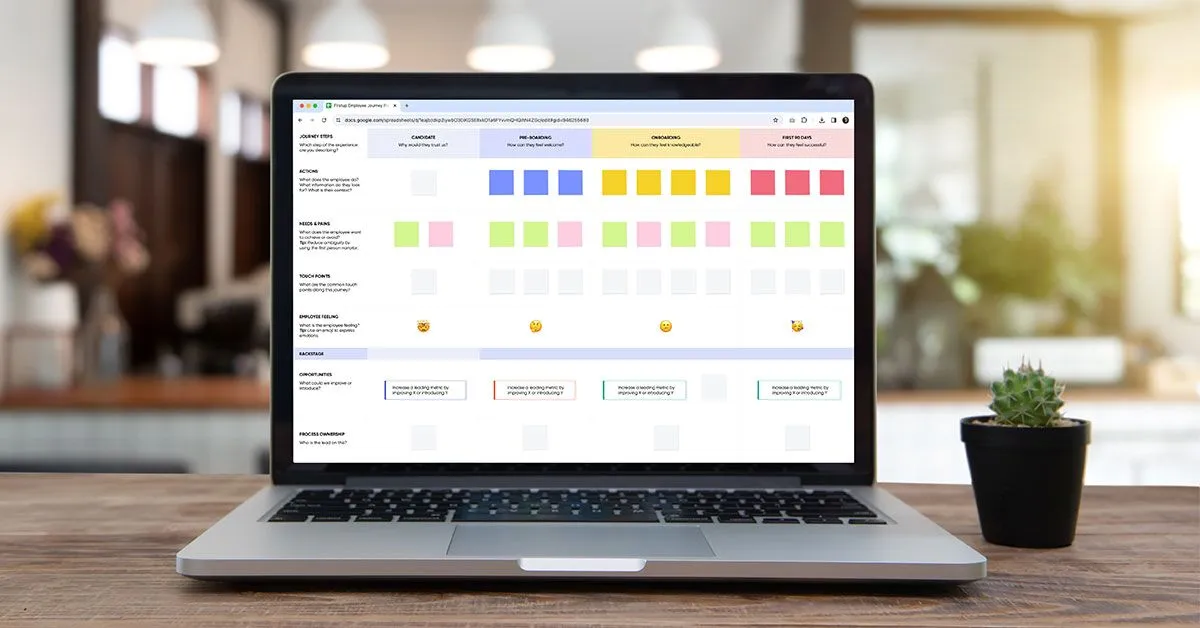National Hispanic Heritage Month
-
New Hire Onboarding Journey
- Welcome to @companyname
- What to expect your first week
- Complete required training
- Bookmark these company resources
- We want your feedback! Take the pulse poll.
- Live our mission, vision & values
- Understand our company strategy
- Action required: Review and sign our company policies
- We want your feedback! Take the pulse poll.
- Navigating our company communication tools
- Learn our company lingo
- Bring your full self to work
- Take the 30-day onboarding survey
- Creating your goals
- Take the 90-day onboarding survey
- Hiring Manager Onboarding Journey
-
Promotions Journey
- A heartfelt congratulations on your promotion
- Five things to do your first week
- Your first 1:1 meeting
- Your first team meeting
- Living our values
- People leader resources
- Leadership skills to get you started
- Recognizing your employees
- Understanding the performance process
- Developing your employees
- DEI and leading
- Recruiting and onboarding process
- Employee wellness
- Leading in your communication platform
- Employee Parental Leave
- Manager Parental Leave
- Other Leave
- Employee Bereavement Leave
- Manager of Employee on Bereavement Journey
- Manager Anniversary Reminder Journey
- Employee Anniversary Journey
- Manager Birthday Journey
- Employee Birthday Journey
- Employee Annual Performance Kickoff Employee Journey
- Manager Annual Performance Kickoff Journey
- Employee Performance Journey Quarterly Reminders
- Manager Performance Journey Quarterly Reminders
- Employee Mentorship Journey
- Manager Open Enrollment Journey
- Employee Open Enrollment Journey
- Employee Offboarding Journey
- Manager Offboarding Journey
- Interns Offboarding Journey
-
Observances Journey
- New Year, New You
- Honoring Martin Luther King Jr. Day
- Happy Lunar New Year
- Honoring Black History Month
- Women’s History Month
- International Women’s Day
- Celebrating Ramadan
- Transgender Day of Visibility
- National Volunteer Month
- Celebrating Earth Day
- Mental Health Month
- Pride Month
- Juneteenth
- Disability Pride Month
- National Hispanic Heritage Month
- World Alzheimer’s Awareness Day
- Breast Cancer Awareness Month
- Indigenous Peoples’ Day
- World Mental Health Day
- Native American Heritage Month
- Day of the Dead
- Veterans Day
- Diwali
- International Volunteer Day
- Share your holiday moments
-
Wellness Journey
- New Year, New You: Get Moving Fitness Challenge
- Celebrate World Sleep Day: Prioritize your rest
- April is Stress Awareness Month
- Grab those greens: It’s Nutrition Month
- Prioritize your heart health this month
- Financial Health Month: Prioritizing your wellbeing
- Stop the stigma: May is Mental Health Month
- World No Tobacco Day: Breathe Easier, Live Healthier!
- Today is World Yoga Day
- Wellness Month
- September is Suicide Prevention Month
- World Alzheimer’s Awareness Day
- October is Breast Cancer Awareness Month.
- World Mental Health Day
- Managing holiday stress
Message Template
Hispanic and Latinx Heritage Month is an annual observance dedicated to celebrating the historical and cultural contributions of the Latinx and Hispanic communities in the United States. Taking place from Sept. 15 to Oct. 15, this event serves as a tribute to how these communities have significantly impacted and enriched American society as a whole.
The theme for this year is [enter annual theme]. It was chosen to recognize the significant achievements of the Hispanic and Latinx communities in the economic and political industries.
Before we dig into the history of the month and provide education, here is what you can do to make a difference this month.
Make a difference
[List ways for employees to participate]
History of LatinX or Hispanic Heritage Month
Initially instituted as a week-long commemoration in 1968 during President Lyndon B. Johnson’s tenure, Hispanic Heritage Month later expanded to a full month, spanning until Oct. 15, following President Ronald Reagan’s declaration in 1988. The Sept. 15 start date remains significant as it aligns with the independence days of Guatemala, Honduras, El Salvador, Nicaragua, and Costa Rica. Likewise, Mexico, Chile, and Belize celebrate their national days on the 16th, 18th, and 21st of September, respectively.
Is it National Latinx or Hispanic Heritage Month?
As National Hispanic Heritage Month unfolds, the discourse about the terms “Hispanic,” “Latino,” “Latinx,” or “Chicanx” often comes to the forefront of national attention. Individuals identifying with any or all of these terms understand that these designations are distinct and not interchangeable. The nuances of their meanings and origins have sparked dialogues about Hispanic and Latino identities.
Hispanic: Created bureaucratically for census purposes by the U.S. government, the term “Hispanic” pertains to individuals in the United States with origins or lineage connected to Spanish-speaking regions, including Spain and all areas in Central and South America that were historically colonized by Spain. However, some individuals distance themselves from the term due to its association with colonialism.
Latino/Latina: This term derives from the Spanish word “latinoamericano/a” and generally encompasses individuals from Latin American countries, regardless of their language. For instance, Brazilians, despite their primary language being Portuguese, are categorized as Latino but not Hispanic. Controversy exists regarding individuals with origins in French Guiana and Dutch-speaking countries in South America and whether they should be considered Latinx.
Latinx: Emerging as a gender-neutral alternative to Latino or Latina, “Latinx” accommodates non-binary identification within the grammatically gendered Spanish language.
Chicano/Chicana/Chicanx: These designations identify individuals of Mexican heritage living in the U.S. Technically, a Chicanx is a subset of the broader Latinx category.
The primary objective of this month-long observance is to honor the heritage of Hispanic, Latinx, and Chicanx communities and to foster greater understanding. To appropriately use these terms, it’s essential to engage with one another as individuals rather than pigeonholing them into a particular label. The best approach is to inquire about an individual’s preferred identification.
Things to consider:
- Share educational resources such as TED Talks to help educate your employees.
- Share charities that your employees can donate to or volunteer at during the month.
- Highlight how your company will be an ally all year.
Recommended resources
Explore our library of resources to help you craft an irresistible employee experience
Foster a sense of belonging and respect through personalized observances journeys
Get started with journey tips and resources
Success! You’ll be hearing from us soon.
By providing your email address, you are agreeing to Firstup’s use of your personal information in accordance with our Privacy Notice, which includes receiving marketing emails about our products.


